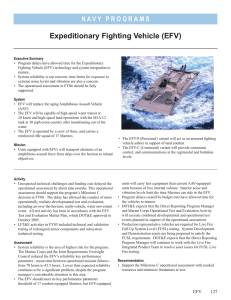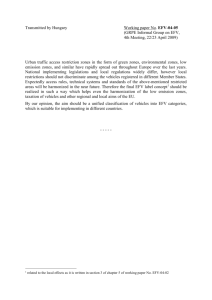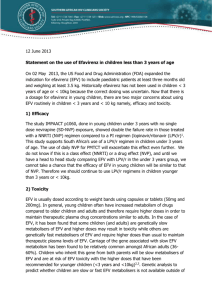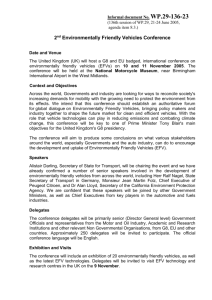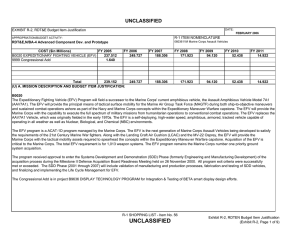Expeditionary Fighting Vehicle (EFV) NAVY PROGRAMS
advertisement
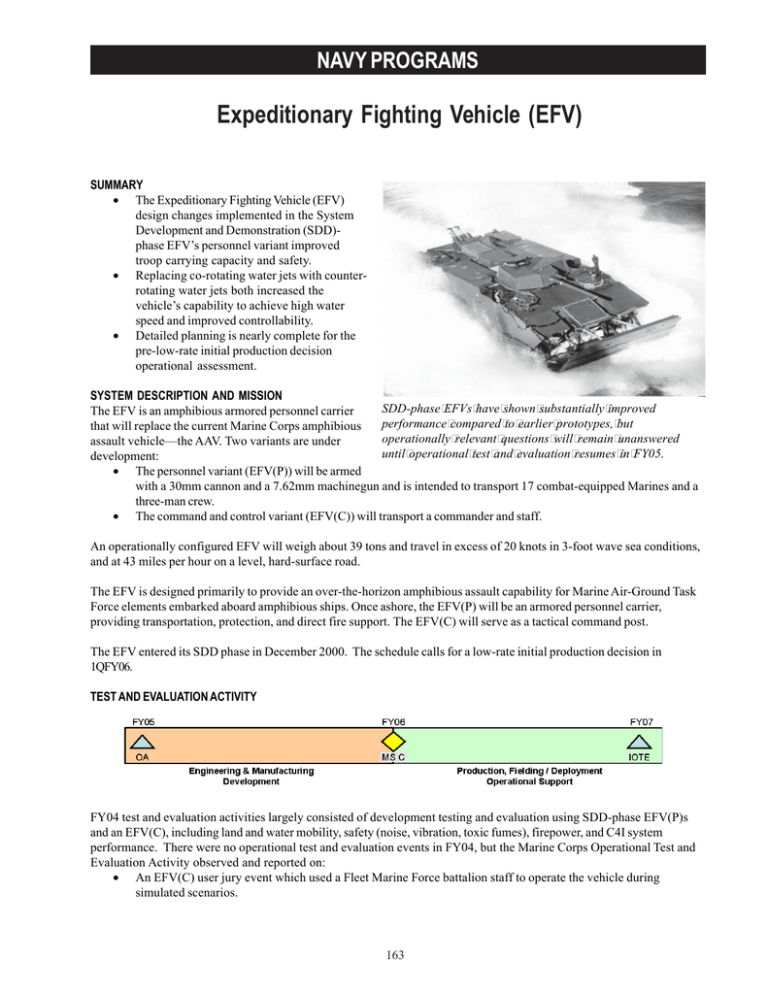
NAVY PROGRAMS Expeditionary Fighting Vehicle (EFV) SUMMARY • The Expeditionary Fighting Vehicle (EFV) design changes implemented in the System Development and Demonstration (SDD)phase EFV’s personnel variant improved troop carrying capacity and safety. • Replacing co-rotating water jets with counterrotating water jets both increased the vehicle’s capability to achieve high water speed and improved controllability. • Detailed planning is nearly complete for the pre-low-rate initial production decision operational assessment. SYSTEM DESCRIPTION AND MISSION SDD-phase EFVs have shown substantially improved The EFV is an amphibious armored personnel carrier performance compared to earlier prototypes, but that will replace the current Marine Corps amphibious operationally relevant questions will remain unanswered assault vehicle—the AAV. Two variants are under until operational test and evaluation resumes in FY05. development: • The personnel variant (EFV(P)) will be armed with a 30mm cannon and a 7.62mm machinegun and is intended to transport 17 combat-equipped Marines and a three-man crew. • The command and control variant (EFV(C)) will transport a commander and staff. An operationally configured EFV will weigh about 39 tons and travel in excess of 20 knots in 3-foot wave sea conditions, and at 43 miles per hour on a level, hard-surface road. The EFV is designed primarily to provide an over-the-horizon amphibious assault capability for Marine Air-Ground Task Force elements embarked aboard amphibious ships. Once ashore, the EFV(P) will be an armored personnel carrier, providing transportation, protection, and direct fire support. The EFV(C) will serve as a tactical command post. The EFV entered its SDD phase in December 2000. The schedule calls for a low-rate initial production decision in 1QFY06. TEST AND EVALUATION ACTIVITY FY04 test and evaluation activities largely consisted of development testing and evaluation using SDD-phase EFV(P)s and an EFV(C), including land and water mobility, safety (noise, vibration, toxic fumes), firepower, and C4I system performance. There were no operational test and evaluation events in FY04, but the Marine Corps Operational Test and Evaluation Activity observed and reported on: • An EFV(C) user jury event which used a Fleet Marine Force battalion staff to operate the vehicle during simulated scenarios. 163 NAVY PROGRAMS • • A developmental test and evaluation event that examined EFV compatibility with Maritime Pre-positioning Force shipping. A developmental test and evaluation event that examined the lethality of various candidate 30mm rounds. The Marine Corps also performed detailed test planning for the pre-low-rate initial production operational assessment. In FY04, the Direct Reporting Program Manager restructured the low-rate initial production entrance criteria and eliminated the Ballistic Vulnerability Test. Live fire tests will now include additional testing on production-like components and full-up system level testing on SDD vehicles. Live Fire Test and Evaluation (LFT&E) activities in FY04 included technical and validation testing of redesigned armors, component technical testing, and revisions of the LFT&E strategy in the Test and Evaluation Master Plan. Technical and validation testing of the new armors will continue into FY05. TEST AND EVALUATION ASSESSMENT Data from contractor developmental test and evaluation, while limited, showed that design changes implemented in the SDD-phase EFV(P)s significantly increased troop carrying capacity and reduced the amount of time it takes for Marines to egress from the vehicle. These improvements make it more likely that EFV(P) will meet the troop carrying capacity Key Performance Parameter and required egress times during the upcoming operational assessment. Land mobility test results have been similarly positive, although challenges remain in ensuring that the vehicle can operate safely on severe slopes. The Marine Corps also conducted tests to confirm the EFV’s capability to negotiate obstacles such as vertical steps and trenches. Water mobility results have been encouraging, particularly in demonstrating the benefits from replacing co-rotating water jets with counter-rotating water jets. This change both increased the vehicle’s capability to achieve high water speed and improved controllability. Reliable performance in the water, particularly of the EFV’s hydrodynamic appendages, has not been demonstrated. Safety-related concerns remain—specifically, high interior noise and vibration levels. Corrective actions have been proposed, but not demonstrated in test. The EFV(C) user jury’s primary objectives were to support an initial assessment of human systems integration, the performance of the installed C4I systems, and conditions inside the vehicle. Conditions were not operationally challenging with respect to communications distances, and the results were generally positive. The participating battalion staff noted that the EFV(C) would substantially exceed the current capability. Areas requiring attention include reducing vibration, integrating own-vehicle position location information with onboard command and control applications, managing co-site interference, and providing a reliable auxiliary power unit. A Maritime Pre-positioning Force compatibility test showed that in most respects the EFV was compatible with Maersk-, AMSEA-, and Waterman-class ships. Unlike AAVs, EFV’s will require lighterage to get ashore during in-stream offloads since the EFV’s greater weight precludes them from using the Maritime Pre-positioning Force ships’ roll-on/roll-off stern ramps to offload and self-deploy. Also, because the EFV’s footprint is roughly 25 percent larger than an AAV’s, deckspace needed to embark EFV units will be correspondingly greater. Developmental testing was conducted to provide data on the terminal ballistic performance of candidate 30mm rounds against personnel, lightly fortified infantry emplacements, light armored vehicles, trucks, and infantry fighting vehicles. These data will be used to select the 30mm rounds that will be employed and, subsequently, to support an evaluation of the contribution of the EFV’s weapons to overall system effectiveness. Overall EFV system reliability remains a significant challenge because of the system’s comparative complexity and harsh operating environment. Even assuming adequate funding of reliability improvement initiatives, the risk is high that the vehicle’s 70-hour mean time between operational mission failures requirement (a Key Performance Parameter) will not be met during IOT&E. The Marine Corps has asked the Joint Requirements Oversight Counsel to reduce the Key Performance Parameter threshold to 43.5 hours, but the reduction has yet to be approved. 164 NAVY PROGRAMS The test program described in the revised LFT&E strategy should be adequate to support the required vulnerability evaluation of the EFV. DOT&E and the Marine Corps Operational Test and Evaluation Agency will continue to leverage developmental testing to refine the scope of full-up system level tests outlined in the LFT&E strategy. SDD-phase EFVs have shown substantially improved performance compared to earlier prototypes, but operationally relevant questions will remain unanswered until operational test and evaluation resumes in FY05. The EFV(P) has not yet demonstrated that it can accomplish its primary mission: that is, transport combat-equipped Marines from an amphibious ship located 20 to 25 nautical miles offshore to objectives located inland without degrading the Marines’ physical condition. The performance of an integrated EFV(C) also will not be demonstrated during operational test and evaluation until FY05. Finally, concerns remain about the use of the less corrosion-resistant aluminum alloy, Al2519, and the potential impact on life cycle cost. 165 NAVY PROGRAMS 166
